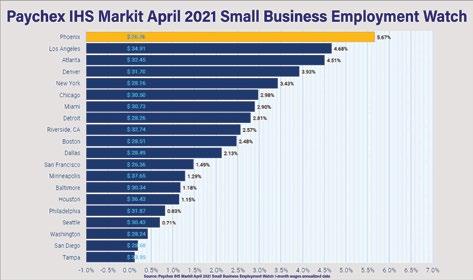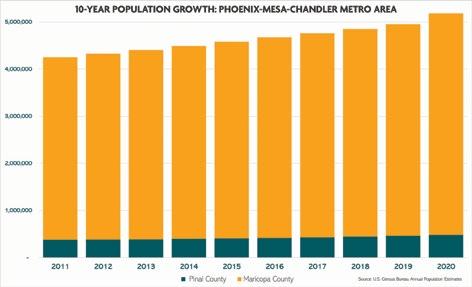
7 minute read
Business
INTERESTED IN SERVING ON A PEORIA CHAMBER COMMITTEE?
We have 4 wonderful committees for you!
Military A airs Committee Government A airs Committee Business Alliance Committee Health & Wellness Committee

The Peoria Chamber of Commerce Launches a New Committee Focused on Health and Wellness
By Scot Andrews, President and CEO, Peoria Chamber of Commerce
The Peoria Chamber of Commerce is focusing on the health and wellness space, and in partnership with local business expertise, working to improve the mind, body and spirit of Peoria residents and businesses to form a new Health and Wellness Committee.
“We are at a moment in history when we have been faced with the reality that true health does not come from a pill bottle, nor from things that are done to us, but rather from our own commitment to our bodies, minds and spirits through our daily habits,” says Sheryl Iszler, owner of Trinity Chiropractic.
The pandemic had an immense impact on all of our social norms. Add the mental frustrations of social distancing in the workplace, personal networks and community, and overall health was damaged. The Peoria Chamber of Commerce believes they can aid in this effort, partnering with their members in the health and wellness space to charter the new Health and Wellness Committee.
Peoria Chamber member companies such as Sun Health, Trinity Chiropractic, Arrowhead and Lake Pleasant Fit Body Boot Camps, Valleywise Health, and Banner Health, to name a few, have joined together to define an agenda to focus on the most common health conditions that impact locals. They seek to help the community maintain and improve their quality of life through healthy lifestyle choices. Interested companies are welcome to join, volunteer and contribute to this journey. By focusing on wellness services and support such as education, balance, mobility, nutrition, fitness, mental health, and weight management, a life can be improved.
Kelly Sullens, owner of both Arrowhead and Lake Pleasant Fit Body Boot Camps, shares, “To build healthy lifestyle choices for the long run, we have to realize that it’s not just proper eating habits and physical activity that aid in making us healthy. We have to be mentally ready to make a change, too. It’s our mission to help open the minds of our community to be ready to make the simple changes that will lead to living happier, living healthier, and living longer, together.”
Kelly will chair the formation of this new Health and Wellness Committee, build a team, and craft the initiatives and milestones that will impact the community to be healthier and more disciplined, one changed life at a time.
The Peoria Chamber is always looking for thought leaders to serve on all of their committees to contribute ideas, create community, and business-based events to improve the quality of life in Peoria and surrounding cities. To learn more about the Peoria Chamber of Commerce and its new committee, visit peoriachamber. com or call 623-979-3601.
Greater Phoenix Adds Thousands of Jobs; Close to Pre-Pandemic Levels
By Eric Jay Toll
The Greater Phoenix metro area gained almost 10,000 jobs in March 2021 over February numbers in the Arizona Office of Economic Opportunity latest report. The Phoenix workforce grew to 2.2 million in the 13 months since the coronavirus pandemic started. Year-over-year, the metro area workforce is still more than 50,000 jobs short of March 2020 numbers.
The OEO data show the Greater Phoenix workforce about 97.6 percent of last year’s number for March. In February 2021, the metro area was at just over 96 percent of the prior year’s job numbers. In terms of numbers, most new jobs fell within the leisure and hospitality sectors, with 4,100 new hires in March, 2,400 in arts and entertainment alone, and another 1,700 in food services and drinking places sector.
Construction hired an additional 2,700 more than February, healthcare added 2,000, transportation and warehousing filled 1,800 positions, and manufacturing added 1,000 new jobs in March. These four industry sectors added over half the new Greater Phoenix jobs in month-over-month.
In year-over-year comparisons, the transportation and warehousing sector added 16,000 new jobs, and healthcare services gained 6,500 jobs over last year. Professional, scientific and technical employment grew by 4,600 in year-over-year, and banking increased new hires by 3,900. Virtually all other industry sectors hired fewer than last year, with leisure and hospitality down by 34,100 workers compared to the previous year.
The Phoenix metro’s unemployment rate dropped to 6.1 percent in March, down from 6.7 percent in February. Last year, while the pandemic started its impacts in March, the severe job losses didn’t occur until April. The unemployment rate in March 2020 for Greater Phoenix was 4.6 percent.
Business
Greater Phoenix Tops Nation in Small Business Wage Gains; Arizona Comes In Third
By Eric Jay Toll
Phoenix topped the nation with a 5.67 percent hourly wage hike, based on one-month annualized wage growth data, in small businesses compared to a year ago, according to the monthly Small Business Employment Watch from Paychex IHS Markit.
The average metro area small business is currently paying wages of $28.26 per hour. The U.S. average is $29.09, increasing only 2.84 percent. Arizona ranked third in wage growth, with a 4 percent increase over last year to $27.11. Missouri’s 4.84 percent growth was tops in the nation, and Georgia was second with 4.4 percent. Wages rose more in the Northeast, up 3.7 percent, followed by 2.94 percent in the West. The South lagged behind the other regions reporting a 2.09 percent wage gain for small business workers.
Arizona and Phoenix, third among states and cities respectively, both placed third in the nation for small business job growth, according to Paychex. For Arizona, April 2021 saw small business job growth of 4.9 percent over April 2020. Greater Phoenix clocked similar growth with a 4.6 percent increase during that time.
Nationally, job gains in April marked the first month in the last 12 in which all regions of the country showed positive growth rates. The West led the regional list with 4.26 percent in job gains. The Midwest was the lowest with a 3.31 percent job gain. According to Paychex, the national average for job gains is 3.92 percent.
Phoenix’s performance has been relatively strong across the last year. After April and May 2020, when jobs plummeted because of the pandemic lockdown, Phoenix was among the top five metro areas for job performance. Over the past year, Greater Phoenix saw fewer jobs lost than most metro areas. In months with job increases, Phoenix was among the leaders.
The monthly Small Business Employment Watch from Paychex IHS Markit calculates job and wage gains based on the data generated by businesses using Paychex for payroll and human resource services. Over the past year, Phoenix has shown substantial numbers in both jobs and wage gains, holding a steady ranking among the top tier of metro areas measured by Paychex.

Maricopa County #1; Greater Phoenix #2: Fastest U.S. Metro Growth in 2020
By Eric Jay Toll
When the news gets out that Greater Phoenix is one of the top places in the nation to find a new job opportunity, people start heading to Arizona. Late in 2018 and early in 2019, that news started getting out in ranking after ranking. Job opportunities await and a new population follows. The jobs available today are filling roles in the expanding knowledge economy, and growing technology, bioscience and manufacturing sectors. The quality of life in the Phoenix metro area is making it easier for companies to recruit from other areas. As of July 1, 2020, the U.S. Census Bureau estimated that the metro area population grew by an average of 291 people every day. Maricopa County saw its population climb by 86,820, more than any other U.S. county.
Census Bureau population estimates differ from the 2020 Decennial Census in that the estimates are calculated projections for the period from July 1, 2019, through June 30, 2020.

Jobs and quality of life are the magnets drawing new populations. More than 80 percent of Arizona’s 2020 population increase moved into Greater Phoenix. Normally, between 67 percent and 70 percent of Arizona’s population lives in Greater Phoenix. With more people moving to metro Phoenix, the more companies looking to expand are drawn to the area for its quality workforce.
The metro area posted a 2.1 percent population gain, the 16th fastest percentage nationally. Greater Phoenix remains the 10th most populous metro area. The three largest metro areas, New York City, Los Angeles and Chicago, all lost substantial populations in 2020 compared to 2019.
The new population in the Phoenix metro was helped by a steady birthrate, 57,251, up from 56,978 in 2019. Bucking the national trend of a declining birth rate, Greater Phoenix held constant, with an average of 57,000 over the last five years.
In 2020, Phoenix added 6,590 people who moved here from foreign countries. The global in-migration, however, was down from nearly 8,300 in 2019. The 2020 number is less than half the 15,575 who moved here from an international address in 2015. The remaining population increases came from other states or counties within Arizona. Metro-to-metro and state-tostate migration data are released late in the summer. Decennial census data won’t be released until late 2021. The first official 2020 Census data released, the reapportionment census, pegged the state’s population at 7.2 million.





